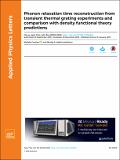Phonon relaxation time reconstruction from transient thermal grating experiments and comparison with density functional theory predictions
Author(s)
Forghani Oozroody, Mojtaba; Hadjiconstantinou, Nicolas
DownloadPublished version (1.775Mb)
Publisher Policy
Publisher Policy
Article is made available in accordance with the publisher's policy and may be subject to US copyright law. Please refer to the publisher's site for terms of use.
Terms of use
Metadata
Show full item recordAbstract
Phonon relaxation time and free path distributions are reconstructed from experimental measurements on a two-dimensional transient thermal grating and compared with density functional theory (DFT) results for silicon. The reconstruction is performed using the inverse problem formulation of Forghani et al. [Phys. Rev. B 94, 155439 (2016)]. The discrepancies observed between reconstructed and DFT results are analyzed in terms of the ability of each set of data to reproduce the experimental temperature relaxation profiles; the reconstructed data are found to predict temperature profiles in closer agreement with the experimental data than the DFT results, possibly due to discrepancies between the actual material and the idealized model studied in the DFT calculations. The reconstructed phonon properties accurately predict temperature relaxation profiles at grating length scales smaller than those spanned by the experimental data. This is a very important feature since in a variety of experimental setups, including the one providing the data in the present study, measurements are not available at all scales spanned by the material free paths. ©2019 Author(s).
Date issued
2019-01Department
Massachusetts Institute of Technology. Department of Mechanical EngineeringJournal
Applied Physics Letters
Publisher
AIP Publishing
Citation
Forghani, Mojtaba and Nicolas G. Hadjiconstantinou, "Phonon relaxation time reconstruction from transient thermal grating experiments and comparison with density functional theory predictions." Applied Physics Letters 114, 2 (January 2019): no. 023106 doi. 10.1063/1.5062846 ©2019 Author(s)
Version: Final published version
ISSN
1077-3118